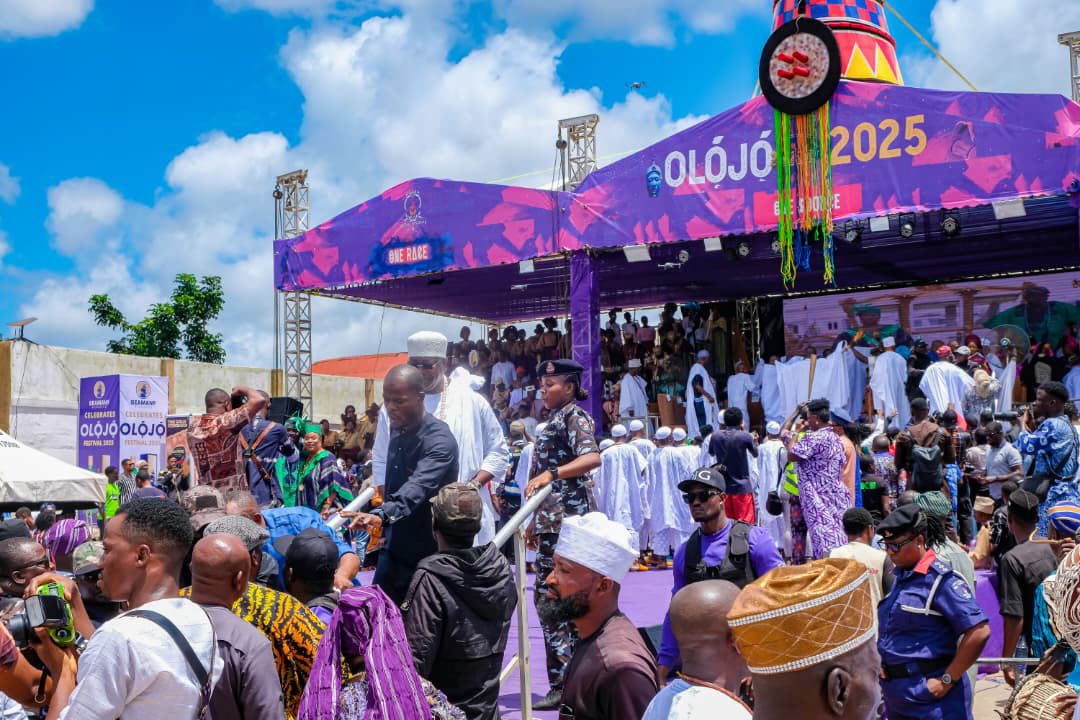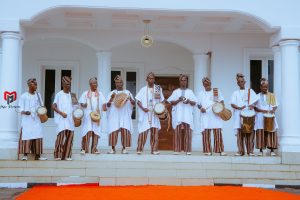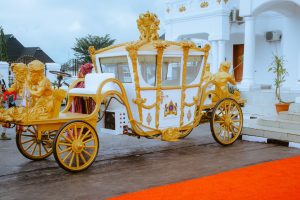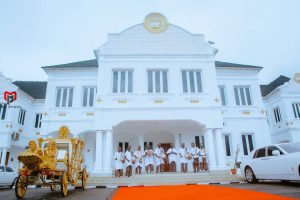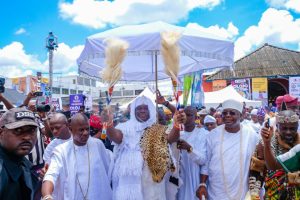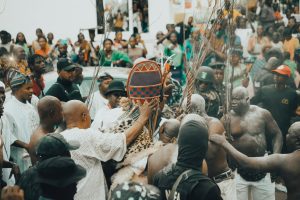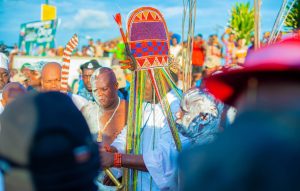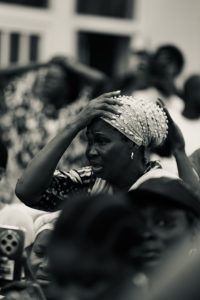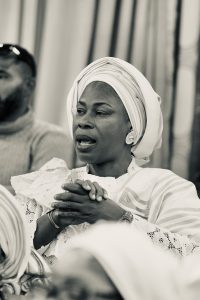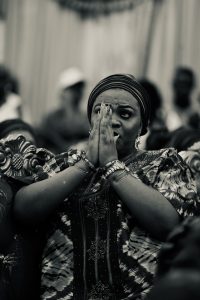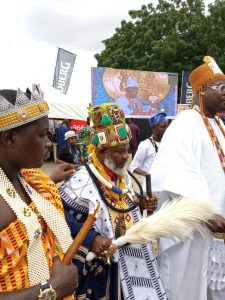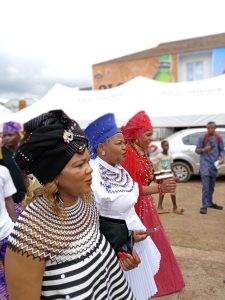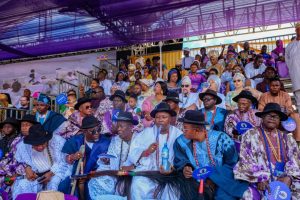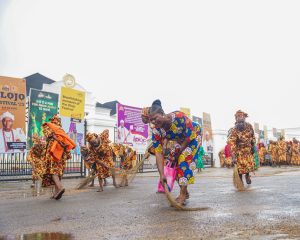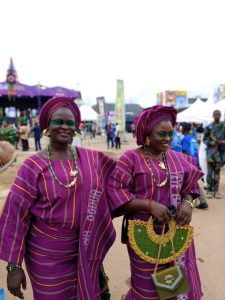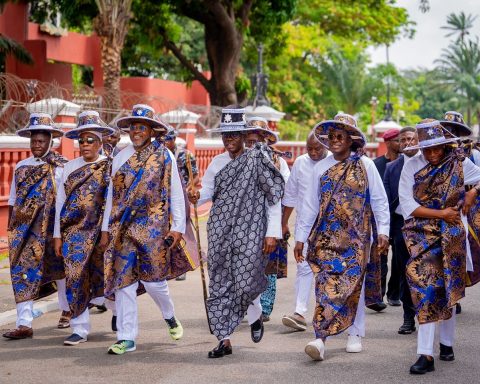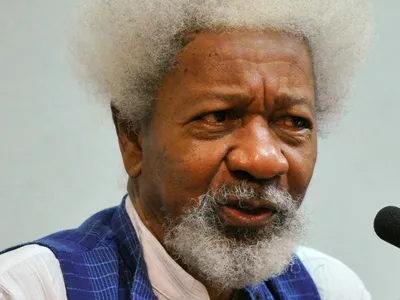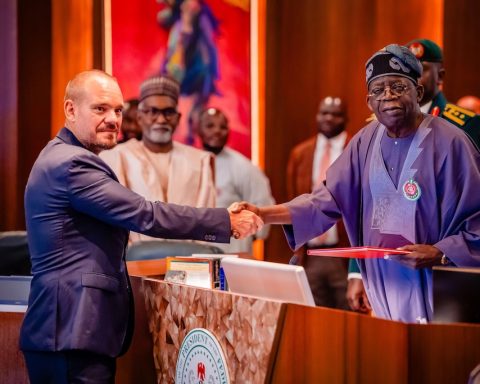As dawn breaks over Ile-Ife, the spiritual heart of the Yoruba world, the ancient city awakens to a rhythm as old as creation itself.
Drums echo across the sacred groves, conch shells announce the day’s significance, and thousands of pilgrims, clad in dazzling white throng the streets. It is Olojo, the “Day of Creation,” a festival that honors Ogun, the god of iron, and celebrates the very moment the earth was formed, according to the people’s beliefs.
Join our WhatsApp Channel
For the Yoruba, Ile-Ife is no ordinary city. Myth tells that it is the cradle of humanity, where Oduduwa, progenitor of the Yoruba people, descended to shape the world. Olojo, observed annually in late September or early October, marks the day when the forces of heaven and earth first converged to give birth to life.
It is a time when the past and present meet, when prayers for prosperity, peace, and protection are offered to the deities who guard the Yoruba cosmos.
Photo speaks:
The Ooni in Seclusion
Days before the festival’s climax, the Ooni of Ife the spiritual and temporal leader of the Yoruba people withdraws into seclusion.
In silence, he fasts, prays, and communes with the ancestors and the Orisa (deities), seeking guidance for his people. This sacred retreat is more than ritual; it is believed to purify the Ooni and strengthen the spiritual connection between the visible world and the divine realm.
When he finally emerges, anticipation reaches a fever pitch. The Ooni is no longer just a monarch, he is a vessel of cosmic energy, ready to bear the weight of history and the hopes of millions.
Esu Joins the Sacred Homage
Among the most spiritually charged moments of the Olojo Festival is the homage paid by Esu, the divine messenger of the Yoruba pantheon. Often misunderstood outside Africa, Esu is not a figure of evil but a powerful intermediary between humans and the Orisa. In Yoruba belief, no prayer or offering reaches the gods without Esu carrying the message.
During the rites, Esu’s priest and devotees arrive in striking red-and-black garments, bearing ritual staffs and offering kola nuts and palm oil. They chant invocations and present sacrifices before the Ooni, acknowledging his role as the earthly bridge to the gods. Their homage affirms Esu’s indispensable task of clearing the cosmic path so that the blessings of Olojo may flow freely.
The Lokoloko Procession: Homage Before the Sacred Crown
As Esu’s devotees withdraw, an electrifying hush spreads through the crowd. The Lokoloko a revered guild of palace aides and ritual attendants begin their solemn procession toward the Ooni. Clad in immaculate white wrappers and adorned with coral beads and sacred insignia, the Lokoloko embody purity and ancestral authority.
Their mission is both ceremonial and spiritual: to pay homage to the Oonirisha (a reverent title for the Ooni, meaning “the living Orisa”) before he dons the sacred Aare crown. Moving in synchronized steps, they chant ancient praise songs, beat ceremonial drums, and raise their staffs to cleanse the path. Their deep, resonant invocations are said to awaken the spirits of the ancestors and call down blessings from the pantheon of Orisa.
This homage signals to all that the Ooni’s transformation from earthly king to spiritual intermediary is near. The atmosphere thickens with reverence and awe every chant, every footfall carries the weight of centuries.
The Aare Crown: A Living Relic of Creation
The highlight of Olojo is the Ooni’s appearance in the Aare crown, a massive, beaded headdress believed to contain the spiritual power of Oduduwa and the collective prayers of the Yoruba nation. The crown is worn only once a year, and only after the Ooni has completed his days of purification. The Sacred ‘AARE CROWN’ is the heaviest beaded crown in Yoruba History, weighing over 50kg.
As the Lokoloko complete their homage, the Ooni emerges, the Aare crown glistening with sacred beads and ancient symbols. The crowd erupts in a roar of praise and song. It is said that during these few hours, the Ooni embodies both king and god, serving as the bridge between humanity and the divine. Prayers offered in this moment whether for rain, fertility, healing, or peace are believed to travel directly to the heavens.
READ ALSO: Five Most Popular Cultural Festivals In Nigeria
Ojúde Ọba Festival: Governor Abiodun Extols Virtues Of Ijebuland
Music, Masquerades, and Marketplaces
Around the spiritual core of the festival swirls a carnival of color and sound. Egungun masquerades, representing ancestral spirits, dance through the streets in a dazzling display of fabrics and swirling masks. Drummers beat the bata and dundun in hypnotic rhythms, while praise singers recount the heroic deeds of Yoruba kings and warriors. Markets overflow with palm wine, roasted yam, spicy pepper soup, and handcrafted beads, turning Ile-Ife into a living classroom of Yoruba art, cuisine, and music.”
In Ile Ife, Olojo is a reminder that our culture is alive”. – Amira Shonubi, a native.
For visitors, the festival is as much a cultural immersion as it is a spiritual pilgrimage. Local guides explain the symbolism of every dance and drumbeat, while priests and priestesses share stories of Ogun, the god of iron, who cleared the path for creation with his machete and tools.
A Festival of Continuity and Hope
Beyond the pageantry lies a deeper purpose. Olojo is a festival of renewal, a time when the Yoruba reaffirm their unity and collective identity. Political leaders and community chiefs attend, not only to honor tradition but also to seek the blessings of the gods for governance and peace.
In a world where modernization and migration threaten indigenous customs, Olojo endures as a living link to Yoruba history. “This is not just culture,” says Chief Adeyemi Ogunlade, a senior priest of Ife. “It is our beginning. When we honor the crown, we honor creation itself.”
Today, Olojo attracts tourists, scholars, and diaspora Yoruba from across the globe. Photographers capture the dazzling fabrics and sacred rituals, while anthropologists marvel at the festival’s seamless blend of spirituality and spectacle. Yet at its heart, Olojo is more than a cultural exhibition, it is a universal reminder of humanity’s shared origins and dependence on the earth.
As night falls and the drums fade into the balmy Ile-Ife air, one truth remains: the earth remembers its beginning, and through Olojo, Yoruba teach the world to remember too.
Amanze Chinonye is a Staff Correspondent at Prime Business Africa, a rising star in the literary world, weaving captivating stories that transport readers to the vibrant landscapes of Nigeria and the rest of Africa. With a unique voice that blends with the newspaper's tradition and style, Chinonye's writing is a masterful exploration of the human condition, delving into themes of identity, culture, and social justice. Through her words, Chinonye paints vivid portraits of everyday African life, from the bustling markets of Nigeria's Lagos to the quiet villages of South Africa's countryside . With a keen eye for detail and a deep understanding of the complexities of Nigerian society, Chinonye's writing is both a testament to the country's rich cultural heritage and a powerful call to action for a brighter future. As a writer, Chinonye is a true storyteller, using her dexterity to educate, inspire, and uplift readers around the world.


